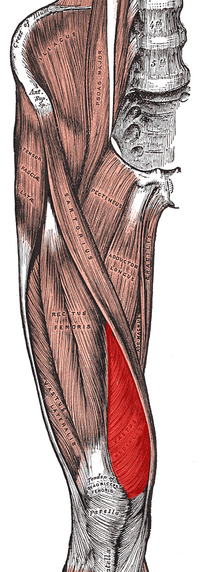Vastus Medialis Oblique: Difference between revisions
No edit summary |
(added a definition at the beginning) |
||
| Line 9: | Line 9: | ||
== Description == | == Description == | ||
The Vastus Medialis Oblique (VMO) muscle is the muscle that makes up the most distal fibres of the [[Vastus Medialis|Vastus Medialis (VM)]] muscle.<ref>El Sawy MM, Mikkawy DM, El-Sayed SM, Desouky AM. [https://www.ncbi.nlm.nih.gov/pmc/articles/PMC8017455/#ref11 Morphometric analysis of vastus medialis oblique muscle and its influence on anterior knee pain. Anatomy & cell biology]. 2021 Mar 1;54(1):1-9.</ref> There is anatomical evidence that the VMO and VM are functionally different due to dissimilar muscle fibre pennation angles. VMO runs obliquely and helps with medial translation of the patella where VM runs more longitudinally and contributes more to knee extension. Patellofemoral joint load is decreased by advanced and adequate medially directed force by the VMO. There has been speculation as to whether VMO and VM can be activated differentially but Peng et al (2018) showed that the two can be activated differentially and that sex and hip position impact their motor unit recruitment properties<ref name=":0">Peng YL, Tenan MS, Griffin L. [https://journals.physiology.org/doi/pdf/10.1152/japplphysiol.00702.2017 Hip position and sex differences in motor unit firing patterns of the vastus medialis and vastus medialis oblique in healthy individuals]. Journal of Applied Physiology. 2018 Jun 1;124(6):1438-46.</ref>. | |||
[[File:VMO1.png|alt=|center|572x572px]] | [[File:VMO1.png|alt=|center|572x572px]] | ||
Revision as of 10:32, 20 January 2024
This article is currently under review and may not be up to date. Please come back soon to see the finished work! (20/01/2024)
Original Editor - Rafet Irmak
Top Contributors - Admin, Ananya Bunglae Sudindar, Rafet Irmak, George Prudden, Wendy Snyders, Kim Jackson, Richard Benes, Evan Thomas, WikiSysop and Claudia Karina
Description[edit | edit source]
The Vastus Medialis Oblique (VMO) muscle is the muscle that makes up the most distal fibres of the Vastus Medialis (VM) muscle.[1] There is anatomical evidence that the VMO and VM are functionally different due to dissimilar muscle fibre pennation angles. VMO runs obliquely and helps with medial translation of the patella where VM runs more longitudinally and contributes more to knee extension. Patellofemoral joint load is decreased by advanced and adequate medially directed force by the VMO. There has been speculation as to whether VMO and VM can be activated differentially but Peng et al (2018) showed that the two can be activated differentially and that sex and hip position impact their motor unit recruitment properties[2].
Origin[edit | edit source]
VMO originates from the adductor magnus tendon[3][4], the medial lip of linea aspera and the medial supracondylar line[4].
Insertion[edit | edit source]
VMO inserts onto the medial border of the patella[3] [4]and the knee joint capsule[4]. It also has a small area where it directly continues with the patella tendon[4].
Action[edit | edit source]
VMO assists with medial translation of the patella[2][4] and assists with the last phase of knee extension[4].
References[edit | edit source]
- ↑ El Sawy MM, Mikkawy DM, El-Sayed SM, Desouky AM. Morphometric analysis of vastus medialis oblique muscle and its influence on anterior knee pain. Anatomy & cell biology. 2021 Mar 1;54(1):1-9.
- ↑ 2.0 2.1 Peng YL, Tenan MS, Griffin L. Hip position and sex differences in motor unit firing patterns of the vastus medialis and vastus medialis oblique in healthy individuals. Journal of Applied Physiology. 2018 Jun 1;124(6):1438-46.
- ↑ 3.0 3.1 Rajput HB, Rajani SJ, Vaniya VH. Variation in morphometry of vastus medialis muscle. Journal of Clinical and Diagnostic Research: JCDR. 2017 Sep;11(9):AC01.
- ↑ 4.0 4.1 4.2 4.3 4.4 4.5 4.6 El Sawy MM, Mikkawy DM, El-Sayed SM, Desouky AM. Morphometric analysis of vastus medialis oblique muscle and its influence on anterior knee pain. Anatomy & cell biology. 2021 Mar 1;54(1):1-9.







